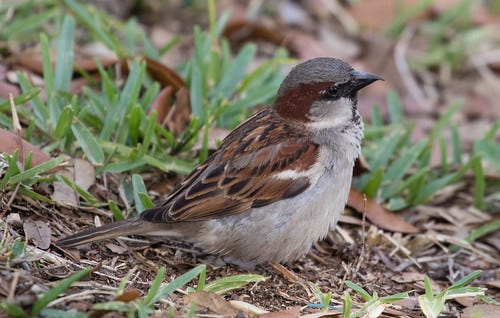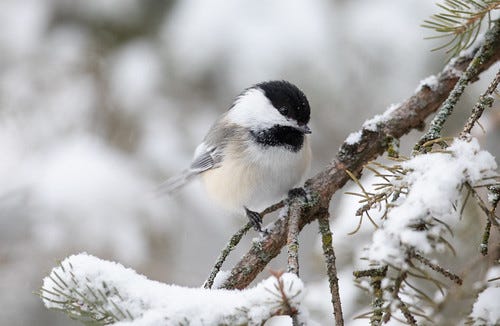(Listen to the radio version here.)
I live in Duluth, Minnesota, which can get pretty darned cold. The coldest temperature on record here was -41ºF on January 2, 1885. That was over a decade before my grandpa was born, but the second coldest temperature ever measured in Duluth, -39ºF, happened on February 2, 1996, while we were living here.
Most years we have at least one or two cold snaps with nighttime temps in the double-digits below zero. On one of those in the late 1980s, Russ and I heard what sounded like a gunshot in the middle of the night. We got up and looked around but everything seemed fine. In the morning when I opened our living room drapes, the inner pane of our thermal-pane window had a diagonal crack all the way across.
On many days, Duluth’s temperature never rises to zero. The most consecutive hours when the temperature never got above zero was 186, amounting to almost 8 straight days, from January 12-20, 1994. That year, Lake Superior’s entire surface froze.
If we’re dressed properly, frigid temperatures can be fun for people. When it’s cold enough, people can hammer a nail into wood using a frozen banana or blow bubbles that instantly freeze and shatter. I made a 6-second video of Russ throwing a cup of boiling water out in subzero temps—it instantly formed snow.
As far as we know, birds don’t play games like that in the cold except for when crows and ravens sometimes slide on or play with snow. But as long as most species of birds have enough food and are acclimated to cold weather, they do surprisingly well in frigid temperatures.

Even naked as jaybirds, birds come attired in the highest quality down underwear imaginable. Most songbirds molt into fresh outer feathers in late summer after the breeding season. Then as temperatures start getting colder, they grow more and more down feathers. Songbirds average between 2,000 and 4,000 feathers and have more in winter than in summer.
In one study in which the researcher took advantage of the fact that House Sparrows have no legal protections, some House Sparrows were trapped and killed in Michigan in July and others in January and February to get feather counts. Those killed in summer averaged 3,100 feathers; those in winter had about 3,600—more than an 11 percent increase. We can’t see those feathers, and they don’t appreciably bulk out a bird’s appearance except on frigid days. Each feather is attached to a tiny muscle that can erect the feather as needed; in cold temperatures, a bird can raise its feathers the way we loft a down sleeping bag to improve its insulation.

As important as the down feathers that cover a bird’s body, the ones insulating its head are even more critical. A full 30–40 percent of a bird’s feathers cover its head and neck.

I’ll never forget February 2, 1996. Not only did Duluth reach our second lowest temperature ever, but up in Tower, Minnesota, the temperature dropped all the way down to -60º F, the all-time coldest temperature ever recorded not just in Minnesota but in any state east of the Mississippi River. It may have gotten even colder in Embarrass, Minnesota, that night—some people’s thermometers showed -61 and -62 there, but embarrassingly, the official thermometer broke.
Weather forecasters had predicted that we might break the record that night, and one guy decided it would be cool to camp out in it. TV and radio stations and newspaper reporters were there in the morning when he emerged triumphant. Everybody was so impressed with him that not one of the reporters or newscasters took note of the chickadees not just chickadee-dee-dee-ing but singing their Hey, sweetie! songs in the background. Those chickadees had each slept in their own individual cavity, naked as jaybirds, no high-tech clothing, hand and foot warmers, or camp stoves at all.
Unlike some small songbirds, chickadees do not snuggle together on even the coldest nights. Instead, they allow their body temperature to drop dramatically overnight and then shiver violently when they first awaken—that muscle action heats their tissues back up to about 105–108º F. Overnight they've burned up most or even all of their fat stores, so they need breakfast as soon as possible. They instantly head to their favorite bird feeder or reliable cache of food to stoke their metabolic furnace. The birds that appear in your yard at first light are the ones most counting on the food provided by your feeders and/or vegetation.

We haven’t dealt with subzero temperatures so far this year, but Saturday morning the temperature in my yard hovered at 5º F until after 9 am. At first light, around 7:30, not one, not two, but all three of my neighborhood Pileated Woodpeckers came to my suet, and throughout the morning, whenever I looked out, I could see at least one of them.
BB and NotBB, the two males, both seem to have a sense of ownership of my yard, and it’s very hard for them to share gracefully, so I set out a third suet feeder in the back of the yard, away from the two suet feeders closer to the house. The close ones aren’t very far apart, but one is north of the house and the other east, with the house blocking the view so both feeders can be occupied without stressing anyone out.
When I woke up Sunday it was 14º. I thought the relatively balmy temperatures were the reason none of the Pileated Woodpeckers showed up at first light—I didn’t notice any until 8:25 am. But not long after one of them called out a couple times, a Cooper’s Hawk flew in—I don’t know whether it just arrived or had been here since dawn.

I almost lost a female Pileated to a Sharp-shinned Hawk six years ago, and Cooper’s are bigger and stronger, so I’m hoping against hope that this one is just passing through or has a taste for pigeons. Raptors are an important element of any healthy ecosystem, but not one I like to see on my corner of Peabody Street. The neighborhood pigeon and starling flocks could stand some thinning out, but I’d just as soon skip being an eyewitness.
Some people glamorize the concept of “nature red in tooth and claw,” and I myself used to thaw out a mouse every night to feed my beloved education owl Archimedes.

I could never have accepted an education bird who needed to be fed live rodents—I’ve made eye contact with too many white mice, gerbils, hamsters, and rats to be able to deal with that, and after having my own brushes with death, my sympathies stand even stronger with the chickadees and Pileated Woodpeckers who never redden their own beaks or claws. Our wintering woodpeckers and songbirds must get enough food during the brief daytime hours to keep them going overnight while also avoiding predators, who are themselves hungry. It’s tough to be a bird!
But they don’t seem to bemoan their fate. Chickadees and Pileated Woodpeckers are not migratory species, and Duluth is well within their range. So far, we haven’t learned how to communicate with them, but I suspect they do most of their complaining during hot spells in summer. Winter? Even the coldest weather is just part of normal daily life.












I love the picture of the Pileated WP all curled up. You're motivating me to get outside at 6 am to fill my feeder! I heard several chickadees calling when I got out there late (7:15) this morning. They were probably cursing me in Chickadee speak.
~Toshia
My husband and I were watching Trumpeter Swans the other day on a nearly frozen lake. He joked we should make them little down jackets - I pointed out that they already had them!